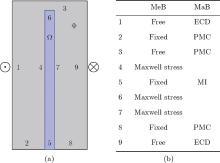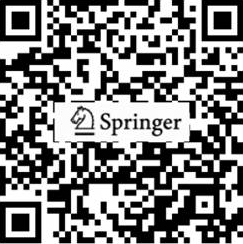Applied Mathematics and Mechanics (English Edition) ›› 2024, Vol. 45 ›› Issue (10): 1717-1732.doi: https://doi.org/10.1007/s10483-024-3174-9
• Articles • Previous Articles Next Articles
Lei WANG1,*( ), Zikun LUO1, Mengkai LU2, Minghai TANG1
), Zikun LUO1, Mengkai LU2, Minghai TANG1
Received:2024-05-26
Online:2024-10-03
Published:2024-09-27
Contact:
Lei WANG
E-mail:wangL@hhu.edu.cn
Supported by:2010 MSC Number:
Lei WANG, Zikun LUO, Mengkai LU, Minghai TANG. A physics-informed neural network for simulation of finite deformation in hyperelastic-magnetic coupling problems. Applied Mathematics and Mechanics (English Edition), 2024, 45(10): 1717-1732.

Fig. 12
Model for magnetically induced bending of cantilever beams: (a) the geometric structure and (b) the boundary conditions, where MeB and MaB represent mechanical and magnetic boundaries, respectively, ECD denotes the external current density, PMC denotes the perfect magnetic conductor, and MI stands for the magnetic insulation (color online)"

| 1 | XU, T. Q., ZHANG, J. C., SALEHIZADEH, M., ONAIZAH, O., and DILLER, E. Millimeterscale flexible robots with programmable three-dimensional magnetization and motions. Science Robotics, 4(29), eaav4494, 4 (29), eaav4494 (2019) |
| 2 | TIAN, T. F., LI, W. H., ALICI, G., DU, H., and DENG, Y. M. Microstructure and magnetorheology of graphite-based MR elastomers. Rheologica Acta, 50, 825- 836 (2011) |
| 3 | DENG, H. X., and GONG, X. L. Adaptive tuned vibration absorber based on magnetorheological elastomer. Journal of Intelligent Material Systems and Structures, 18 (12), 1205- 1210 (2007) |
| 4 | LI, Y. C., LI, J. C., LI, W. H., and DU, H. P. A state-of-the-art review on magnetorheological elastomer devices. Smart Materials and Structures, 23 (12), 123001 (2014) |
| 5 | JOLLY, M. R., CARLSON, J. D., and MUNOZ, B. C. A model of the behaviour of magnetorheological materials. Smart Materials and Structures, 5 (5), 607 (1996) |
| 6 | BELLAN, C., and BOSSIS, G. Field dependence of viscoelastic properties of MR elastomers. International Journal of Modern Physics B, 16 (17n18), 2447- 2453 (2002) |
| 7 | TESSIER-DOYEN, N., GLANDUS, J. C., and HUGER, M. Experimental and numerical study of elastic behavior of heterogeneous model materials with spherical inclusions. Journal of Materials Science, 42, 5826- 5834 (2007) |
| 8 | KHAN, A., GHORBANIAN, V., and LOWTHER, D. Deep learning for magnetic fleld estimation. IEEE Transactions on Magnetics, 55 (6), 7202304 (2019) |
| 9 | RAISSI, M., PERDIKARIS, P., and KARNIADAKIS, G. E. Physics-informed neural networks: a deep learning framework for solving forward and inverse problems involving nonlinear partial difierential equations. Journal of Computational Physics, 378, 686- 707 (2019) |
| 10 |
FUHG, J. N., KARMARKAR, A., KADEETHUM, T., YOON, H., and BOUKLAS, N. Deep convolutional Ritz method: parametric PDE surrogates without labeled data. Applied Mathematics and Mechanics (English Edition), 44 (7), 1151- 1174 (2023)
doi: 10.1007/s10483-023-2992-6 |
| 11 | OKUDA, T., SAIDA, T., MATONO, G., and NISHIO, M. Digital twin framework for real-time dynamic analysis visualization with detecting dynamic changes in structures properties using PINN. Sensors and Smart Structures Technologies for Civil, Mechanical, and Aerospace Systems 2023, 247-253, SPIE, California (2023) |
| 12 | KIM, S., CHOI, J. H., and KIM, N. H. Data-driven prognostics with low-fldelity physical information for digital twin: physics-informed neural network. Structural and Multidisciplinary Optimization, 65 (9), 255 (2022) |
| 13 | KOVACS, A., EXL, L., KORNELL, A., FISCHBACHER, J., HOVORKA, M., GUSENBAUER, M., BRETH, L., OEZELT, H., PRAETORIUS, D., SUESS, D., and SCHREFL, T. Magnetostatics and micromagnetics with physics informed neural networks. Journal of Magnetism and Magnetic Materials, 548, 168951 (2022) |
| 14 | RAO, C. P., SUN, H., and LIU, Y. Physics-informed deep learning for computational elastodynamics without labeled data. Journal of Engineering Mechanics, 147 (8), 04021043 (2021) |
| 15 | JAGTAP, A. D., KHARAZMI, E., and KARNIADAKIS, G. E. Conservative physics-informed neural networks on discrete domains for conservation laws: applications to forward and inverse problems. Computer Methods in Applied Mechanics and Engineering, 365, 113028 (2020) |
| 16 | ROCHE, J., VON LOCKETTE, P., and LOFLAND, S. Study of hard-and soft-magnetorheological elastomers (MRE's) actuation capabilities. Proceedings of the 2011 COMSOL Conference in Boston, COMSOL, Burlington/Massachusetts (2021) |
| 17 | SODOMKA, O., SKRIVAN, V., and MACH, F. Magnetic forces behind hyperelastic behavior of magnetorheological elastomers. IEEE Transactions on Magnetics, 56 (7), 1- 4 (2020) |
| 18 | HORNIK, K., STINCHCOMBE, M., and WHITE, H. Multilayer feedforward networks are universal approximators. Neural Networks, 2 (5), 359- 366 (1989) |
| 19 | BAYDIN, A. G., PEARLMUTTER, B. A., RADUL, A. A., and SISKIND, J. M. Automatic difierentiation in machine learning: a survey. Journal of Machine Learning Research, 18 (153), 1- 43 (2018) |
| 20 | SAMANIEGO, E., ANITESCU, C., GOSWAMI, S., NGUYEN-THANH, V. M., GUO, H., HAMDIA, K., ZHUANG, X. Y., and RABCZUK, T. An energy approach to the solution of partial difierential equations in computational mechanics via machine learning: concepts, implementation and applications. Computer Methods in Applied Mechanics and Engineering, 362, 112790 (2020) |
| 21 | WANG, S. F., TENG, Y. J., and PERDIKARIS, P. Understanding and mitigating gradient flow pathologies in physics-informed neural networks. SIAM Journal on Scientiflc Computing, 43 (5), A3055- A3081 (2021) |
| 22 | HAGHIGHAT, E., RAISSI, M., MOURE, A., GOMEZ, H., and JUANES, R. A physics-informed deep learning framework for inversion and surrogate modeling in solid mechanics. Computer Methods in Applied Mechanics and Engineering, 379, 113741 (2021) |
| 23 | ABBASI, A., SANO, T. G., YAN, D., and REIS, P. M. Snap buckling of bistable beams under combined mechanical and magnetic loading. Philosophical Transactions of the Royal Society A, 381 (2244), 20220029 (2023) |
| 24 | HAGHIGHAT, E., BEKAR, A. C., MADENCI, E., and JUANES, R. A nonlocal physics-informed deep learning framework using the peridynamic difierential operator. Computer Methods in Applied Mechanics and Engineering, 385, 114012 (2021) |
| [1] | K. CHANDAN, K. KARTHIK, K. V. NAGARAJA, B. C. PRASANNAKUMARA, R. S. VARUN KUMAR, T. MUHAMMAD. Radiative heat transfer analysis of a concave porous fin under the local thermal non-equilibrium condition: application of the clique polynomial method and physics-informed neural networks [J]. Applied Mathematics and Mechanics (English Edition), 2024, 45(9): 1613-1632. |
| [2] | Long WANG, Lei ZHANG, Guowei HE. Chien-physics-informed neural networks for solving singularly perturbed boundary-layer problems [J]. Applied Mathematics and Mechanics (English Edition), 2024, 45(9): 1467-1480. |
| [3] | Jing'ang ZHU, Yiheng XUE, Zishun LIU. A transfer learning enhanced physics-informed neural network for parameter identification in soft materials [J]. Applied Mathematics and Mechanics (English Edition), 2024, 45(10): 1685-1704. |
| [4] | J. N. FUHG, A. KARMARKAR, T. KADEETHUM, H. YOON, N. BOUKLAS. Deep convolutional Ritz method: parametric PDE surrogates without labeled data [J]. Applied Mathematics and Mechanics (English Edition), 2023, 44(7): 1151-1174. |
| [5] | Xuhui MENG. Variational inference in neural functional prior using normalizing flows: application to differential equation and operator learning problems [J]. Applied Mathematics and Mechanics (English Edition), 2023, 44(7): 1111-1124. |
| [6] | Yichuan HE, Zhicheng WANG, Hui XIANG, Xiaomo JIANG, Dawei TANG. An artificial viscosity augmented physics-informed neural network for incompressible flow [J]. Applied Mathematics and Mechanics (English Edition), 2023, 44(7): 1101-1110. |
| [7] | Zhiping MAO, Xuhui MENG. Physics-informed neural networks with residual/gradient-based adaptive sampling methods for solving partial differential equations with sharp solutions [J]. Applied Mathematics and Mechanics (English Edition), 2023, 44(7): 1069-1084. |
| [8] | W. WU, M. DANEKER, M. A. JOLLEY, K. T. TURNER, L. LU. Effective data sampling strategies and boundary condition constraints of physics-informed neural networks for identifying material properties in solid mechanics [J]. Applied Mathematics and Mechanics (English Edition), 2023, 44(7): 1039-1068. |
| [9] | Yuanjun DAI, Yiran AN, Zhi LI, Jihua ZHANG, Chao YU. Fourier neural operator with boundary conditions for efficient prediction of steady airfoil flows [J]. Applied Mathematics and Mechanics (English Edition), 2023, 44(11): 2019-2038. |
| [10] | Dong WU, Yixing HUANG, Ming LEI, Zeang ZHAO, Xiaogang GUO, Daining FANG. Stiffness and toughness of soft/stiff suture joints in biological composites [J]. Applied Mathematics and Mechanics (English Edition), 2022, 43(10): 1469-1484. |
| [11] | Zixuan LU, Liang GUO, Hongyu ZHAO. Mechanics of nonbuckling interconnects with prestrain for stretchable electronics [J]. Applied Mathematics and Mechanics (English Edition), 2021, 42(5): 689-702. |
| [12] | Siyu WANG, Lin ZHAN, Huifeng XI, Heng XIAO. New finite strain elastoplastic equations for accurately and explicitly simulating pseudoelastic-to-plastic transition effects of shape memory alloys [J]. Applied Mathematics and Mechanics (English Edition), 2020, 41(10): 1583-1596. |
| [13] | Jiusheng REN, Chengmin WANG. Electromechanical responses and instability of electro-active polymer cylindrical shells [J]. Applied Mathematics and Mechanics (English Edition), 2016, 37(8): 1067-1076. |
| [14] | ZHANG Shan-yuan;LIU Zhi-fang. Three kinds of nonlinear dispersive waves in elastic rods with finite deformation [J]. Applied Mathematics and Mechanics (English Edition), 2008, 29(7): 909-917 . |
| [15] | LIU Zhi-fang;ZHANG Shan-yuan. SOLITARY WAVES IN FINITE DEFORMATION ELASTIC CIRCULAR ROD [J]. Applied Mathematics and Mechanics (English Edition), 2006, 27(10): 1431-1437 . |
| Viewed | ||||||
|
Full text |
|
|||||
|
Abstract |
|
|||||


 Email Alert
Email Alert RSS
RSS